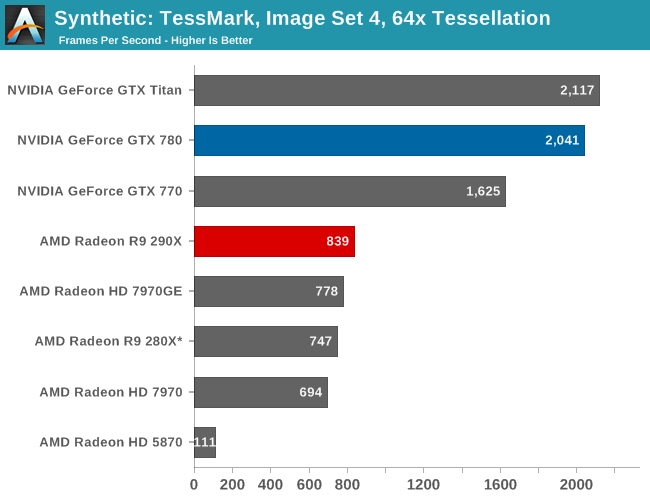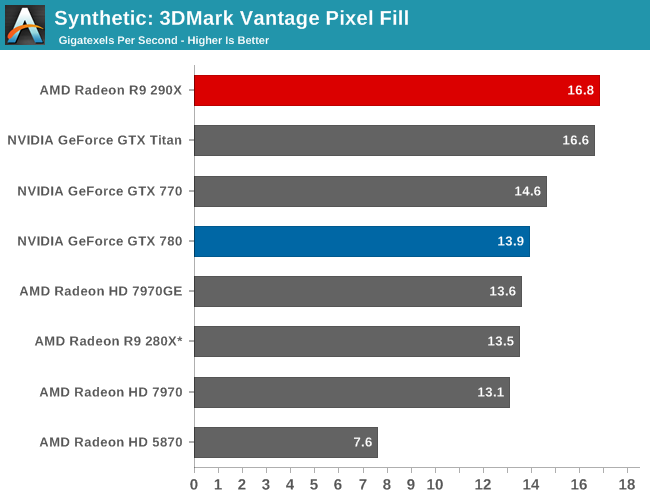The AMD Radeon R9 290X Review
by Ryan Smith on October 24, 2013 12:01 AM EST- Posted in
- GPUs
- AMD
- Radeon
- Hawaii
- Radeon 200
Synthetics
As always we’ll also take a quick look at synthetic performance. The 290X shouldn’t pack any great surprises here since it’s still GCN, and as such bound to the same general rules for efficiency, but we do have the additional geometry processors and additional ROPs to occupy our attention.

Right off the bat then, the TessMark results are something of a head scratcher. Whereas NVIDIA’s performance here has consistently scaled well with the number of SMXes, AMD’s seeing minimal scaling from those additional geometry processors on Hawaii/290X. Clearly Tessmark is striking another bottleneck on 290X beyond simple geometry throughput, though it’s not absolutely clear what that bottleneck is.
This is a tessellation-heavy benchmark as opposed to a simple massive geometry bencehmark, so we may be seeing a tessellation bottleneck rather than a geometry bottleneck, as tessellation requires its own set of heavy lifting to generate the necessary control points. The 12% performance gain is much closer to the 11% memory bandwidth gain than anything else, so it may be that the 280X and 290X are having to go off-chip to store tessellation data (we are after all using a rather extreme factor), in which case it’s a memory bandwidth bottleneck. Real world geometry performance will undoubtedly be better than this – thankfully for AMD this is the pathological tessellation case – but it does serve of a reminder of how much more tessellation performance NVIDIA is able to wring out of Kepler. Though the nearly 8x increase in tessellation performance since 5870 shows that AMD has at least gone a long way in 4 years, and considering the performance in our tessellation enabled games AMD doesn’t seem to be hurting for tessellation performance in the real world right now.
Moving on, we have our 3DMark Vantage texture and pixel fillrate tests, which present our cards with massive amounts of texturing and color blending work. These aren’t results we suggest comparing across different vendors, but they’re good for tracking improvements and changes within a single product family.

Looking first at texturing performance, we can see that texturing performance is essentially scaling 1:1 with what the theoretical numbers say it should. 36% better texturing performance over 280X is exactly in line with the increased number of texture units versus 280X, at the very least proving that 290X isn’t having any trouble feeding the increased number of texture units in this scenario.

Meanwhile for our pixel fill rates the results are a bit more in the middle, reflecting the fact that this test is a mix of ROP bottlenecking and memory bandwidth bottlenecking. Remember, AMD doubled the ROPs versus 280X, but only gave it 11% more memory bandwidth. As a result the ROPs’ ability to perform is going to depend in part on how well color compression works and what can be recycled in the L2 cache, as anything else means a trip to the VRAM and running into those lesser memory bandwidth gains. Though the 290X does get something of a secondary benefit here, which is that unlike the 280X it doesn’t have to go through a memory crossbar and any inefficiencies/overhead it may add, since the number of ROPs and memory controllers is perfectly aligned on Hawaii.










396 Comments
View All Comments
SirRaulo - Tuesday, October 29, 2013 - link
Game changer!A faster card and $100 cheaper... even an nvidia fanboy would know the difference.... wait, a fanboy wouldnt... too bad.
willis936 - Tuesday, October 29, 2013 - link
The game has changed twice a year for the past 20 years. If the change isn't changing one could argue that the game is staying the same.apaceeee - Tuesday, October 29, 2013 - link
Er...I don't think so ..polaco - Tuesday, October 29, 2013 - link
I have seen you used AMD Catalyst 13.11 (Beta 5) in the 290X benchmarks. Maybe would be nice if you can post some with the updated revision as they say to improve performance from 8% to 30% in several games.http://support.amd.com/en-us/kb-articles/Pages/lat...
Thanks!
Ryan Smith - Tuesday, October 29, 2013 - link
Those are versus Catalyst 13.9. There are no performance improvements in our game set between 13.11 v5 and v6.polaco - Tuesday, October 29, 2013 - link
Oh, ok if you say so. I got confused coz in one place it states that explicitly and in the other does not."Performance improvements for the AMD APU Series (comparing AMD Catalyst 13.11 Beta6 to AMD Catalyst 13.9)" in the other place doesn't make that clarification just
"Performance improvements"
wiyosaya - Wednesday, October 30, 2013 - link
Personally, I think it would have been interesting to see a GTX 580 thrown in for the compute benchmarks.rogerthat1945 - Thursday, October 31, 2013 - link
The ASUS GTX 780 went up in price $120+ USD for me last night when I was expecting a price drop thids morning.Last week (and all last month at least, the ASUS GTX 780 price was around $745 USD (in Yen) on Amazon Jp.
I put one in my shoping basket, and browsed some more for extra items (Zx Evo Headset considerations), and then heard about the NVidia cards price to be dropped for the GTX 780 range; so I held off going to checkout; however, this morning when I went to look at paying via the advertised price drop, BUT I found that Amazon have JACKED-UP the price to $867 US. :no:
http://www.amazon.co.jp/ASUSTeK-GTX780%E3%83%81%E3...
Question is;-
"Where can I buy this card for a `proper` price (which popular site) where they will POST it via Air Mail to Japan (not a US military address)? :ange:
Every site I tried from California to China do not post to Japan.
Amazon Japan, you are Kraaayyy-Zee crayon users. :pt1cable:
photek242 - Saturday, November 2, 2013 - link
Now i have a GTX 680 sli setup i think to sell the 2 cards and buy a AMD R290xOr stay with the sli setup?
Here in belgium the r290x goes between 465 - 550 euro
Tia
muziqaz - Sunday, November 3, 2013 - link
Ryan, I don't know if you are still reading this or not, but regarding Vegas Pro, I suppose other codecs do not use GPUs as expected. I use mp4 format and even though sony and AMD are telling me that GPUs do accelerate that format it actually do not. I can't even get my 12 thread CPU to be loaded fully. Or maybe there is another codec which is supported by youtube which might get some GPU acceleration if enabled? maybe someone else can pitch in with suggestions? :)